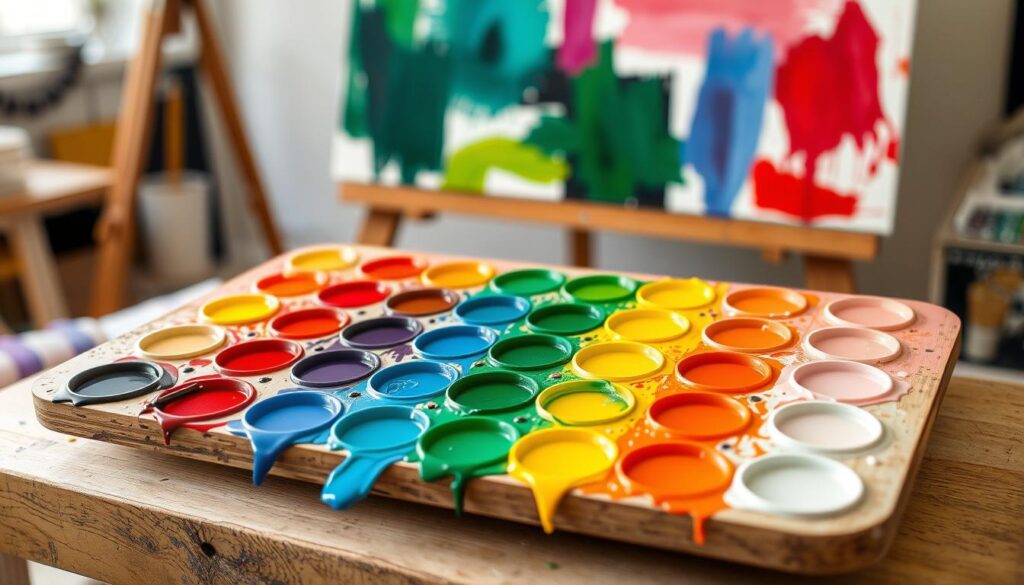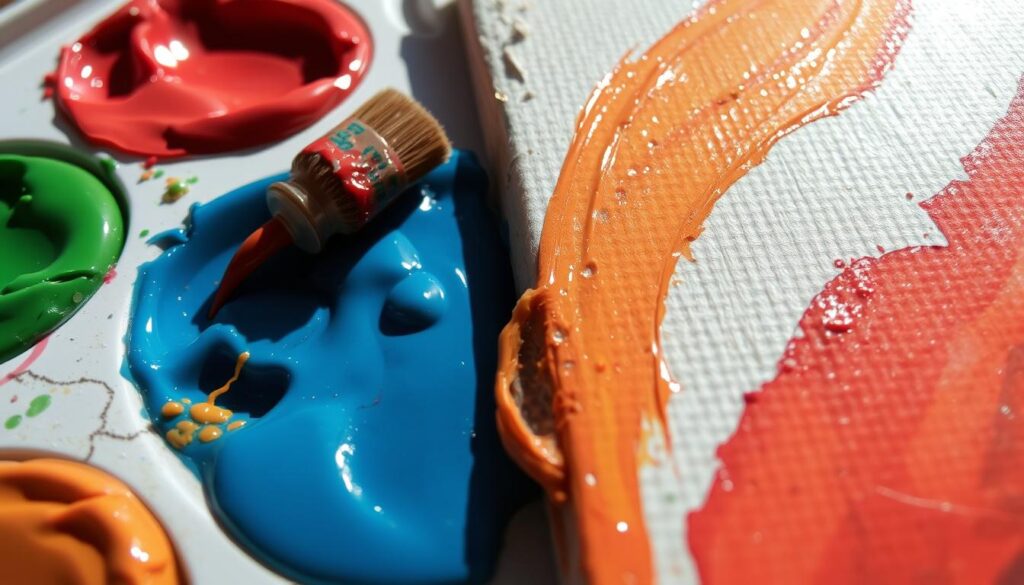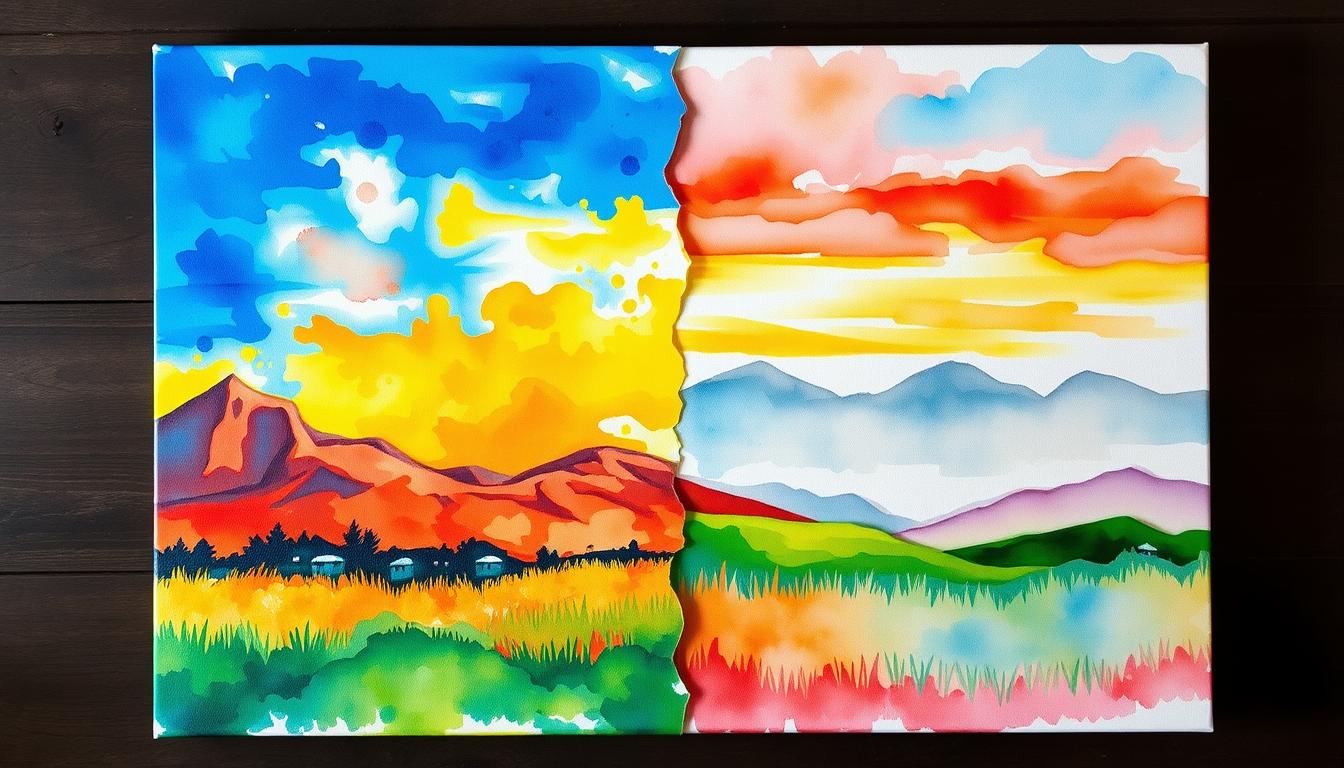This post contains affiliate links.
As an artist, I find painting both calming and exciting. Watching colors blend, textures form, and emotions come to life on canvas is amazing. But, with many painting mediums out there, picking the right one can be tough. Today, we’ll explore acrylic and watercolor painting. We’ll look at their special qualities, benefits, and downsides to help you find your artistic voice.
Key Takeaways
- Acrylic paints bring bright colors, flexibility, and lasting quality. Watercolors offer soft, clear layers and dry fast.
- Acrylics work on many surfaces like canvas, wood, and paper. Watercolors are best for specific watercolor papers.
- Acrylics dry fast, making it easy to layer and fix mistakes. Watercolors need patience and can be hard to control.
- Watercolors are cheaper and easy to carry, perfect for artists always on the move. Acrylics need more supplies.
- Choosing between acrylics and watercolors depends on your style, what you want to create, and your project’s needs.
Introduction to Acrylic and Watercolor Painting
Acrylic and watercolor paints are favorites among artists. They are both water-based painting mediums. But, they have unique qualities for different painting techniques and styles.
Overview of the Painting Mediums
Acrylic paints were introduced in the 1950s. They are now a top choice for artists. With over 90+ colors, artists can mix and blend to create endless shades. Acrylics are known for their durability and brightness, keeping colors vibrant over time.
Watercolor paints have a long history, dating back to ancient Egypt and China. They are safe, odorless, and quick-drying. Available in tubes and blocks, they offer different feels and portability.
Similarities and Differences
Both acrylic and watercolor paints are water-based. They can be diluted and cleaned with water. But, they differ in composition, application, and artistic effects.
- Acrylics dry fast, in 1 ½ to 2 hours. Watercolors dry quicker, in 1 minute to 15 minutes, depending on paint thickness and water use.
- Acrylics are water-resistant when dry. Watercolors can be reactivated with water, making layering tricky without blending.
- Starting with acrylic painting costs $20 to $50. Watercolor sets start at $10 to $30. But, watercolor needs special painting surfaces, adding to costs.
Knowing the key differences between acrylic and watercolor is key. It helps choose the right medium for your artistic goals and style.
What are Acrylic Paints?
Acrylic paint is a water-based medium that artists love for its special qualities. It’s different from oil paints because it uses an acrylic polymer emulsion as its binder. This makes it water-soluble but very durable once it dries.
Composition and Properties of Acrylic Paints
The acrylic resin in these paints holds the pigments together. This creates a flexible, water-resistant paint film that works on many surfaces. With over 90 vibrant colors to choose from, artists have a wide range to play with. Plus, acrylic paints dry fast, with thin layers drying in minutes and thicker ones in a few days.
Advantages of Using Acrylic Paints
- Versatility: Acrylic paints can be mixed with other mediums for unique effects, opening up more creative options.
- Vibrant Colors: The acrylic binder helps create bright, vivid colors that really pop on the canvas.
- Ease of Use: Being water-based, acrylic paints are easier to work with and clean up than oil paints.
- Durability: Acrylic paintings are tough and can keep their color and quality over time.
Acrylic paints are a favorite among artists because of their unique composition, properties, and many benefits. They offer versatility, vibrant colors, ease of use, and durability, making them a top choice for both pros and hobbyists.

What are Watercolor Paints?
Watercolor paints are a traditional art form. They are made of pigments mixed with water. This mix makes watercolors flow and blend easily, creating soft, dreamy paintings.
Watercolor painting has been around for thousands of years. It’s loved by artists who prefer working with water. This method lets them create light, airy pieces.
Watercolor paints are available in solid blocks and liquid tubes. This variety makes them easy to carry and use. They dry fast, usually in 5 to 15 minutes. This quick drying is great for artists who like to work quickly.
Watercolors are also more affordable than acrylics. This makes them perfect for artists who want to try new things without spending a lot.
| Watercolor Painting Characteristics | Advantages | Disadvantages |
|---|---|---|
| Water-based composition | Transparent and ethereal effects | Drying too quickly, making techniques challenging |
| Quick-drying nature | Suitable for travel and fast-paced painting | Reactivation with water can pose challenges |
| Affordability | Cost-effective option for artists | Varying levels of lightfastness |
Watercolor paints offer a unique and beautiful painting experience. But, they also come with challenges like drying fast and tricky techniques. Still, for artists who love working with water, the results are stunning.
Advantages of Acrylic Paints
Acrylic paints are known for their great versatility and bright colors. They are water-based, making them perfect for many creative projects. Their acrylic paint versatility shines when mixed with different mediums, opening up new techniques and effects. With over 90+ shades, artists can mix and blend to create countless colors and hues.
Another big plus is how easy acrylic paint is to use. They can be thinned with water and cleaned with soap and water. This makes them great for beginners. Plus, their acrylic paint durability is unmatched. The acrylic resin keeps the pigments together, making the paint flexible and long-lasting.
| Acrylic Paint Advantages | Specifications |
|---|---|
| Versatility | Can be easily mixed and blended with other acrylic mediums |
| Vibrant Colors | Over 90+ shades available for a wide range of color possibilities |
| Ease of Use | Water-based, can be thinned with water and cleaned up with soap and water |
| Durability | Acrylic resin binding creates a flexible, long-lasting paint film |
“Acrylic paints offer an exceptionally wide variety of vibrant, highly pigmented colors that can be combined to create an infinite number of shades and tones.”
Disadvantages of Acrylic Paints
Acrylic paints have many benefits, but they also have some downsides. One issue is the choice overload that can confuse new artists. They might feel lost with so many colors to choose from. Also, acrylics tend to darken as they dry, making it hard to guess the final color of a painting.
Another problem is their quick-drying nature. This can make blending harder. Artists need to work fast to get the right look. Plus, while they stick well to porous surfaces, they don’t work as well on non-porous materials like glass and some plastics. This might mean extra steps like special preparation and priming.
| Acrylic Paint Drawbacks | Description |
|---|---|
| Choice Overload | The wide range of color options can be overwhelming for beginner artists. |
| Darkening When Dry | Acrylic paints tend to darken in color as they dry, making it difficult to predict the final hue. |
| Quick-Drying Nature | The rapid drying time of acrylics can make techniques like blending more challenging. |
| Surface Compatibility | Acrylics adhere well to porous surfaces but are less compatible with non-porous materials, such as glass and some plastics. |

“The wide range of color options available in acrylic paints can sometimes lead to ‘choice overload,’ particularly for beginner artists who may feel overwhelmed by the sheer number of possibilities.”
Advantages of Watercolor Paints
Watercolor paints are loved by many artists for good reasons. They are made from water, making them safe and eco-friendly. These paints are also non-toxic and have no strong smells. This means artists can work in small spaces without worrying about harmful fumes.
Watercolors are also easy on the wallet. There are many options available at different prices. This makes them perfect for both new and experienced artists. They dry fast, helping artists finish their work quickly. Plus, they are easy to carry around, making them great for painting outdoors or in a studio.
| Watercolor Paint Advantages | Details |
|---|---|
| Water-based and safe to use | Watercolors are typically non-toxic and odorless, making them a safe choice for artists. |
| Affordability | Watercolors offer a wide range of affordable options at various price points. |
| Quick-drying | Watercolor paints dry quickly, allowing artists to work efficiently and make progress on their paintings in a shorter amount of time. |
| Portability | The compact size of watercolor materials makes them a convenient choice for both studio and plein air painting. |
Watercolor paints are great because they are water-based, affordable, dry fast, and easy to carry. These qualities make them a favorite among artists of all levels. Their popularity shows how versatile and accessible watercolors are in the art world.
Disadvantages of Watercolor Paints
Watercolor paints dry fast, which can be both good and bad. This quick drying means mistakes are hard to fix. Also, learning to use watercolor techniques well takes a lot of practice and skill.
Watercolor paintings need special watercolor paper to look right. The wrong paper can make the painting bleed or warp. Plus, watercolor paintings don’t last as long as some other types, especially outside or over time, because the colors can fade or get damaged.
| Watercolor Paint Drawbacks | Description |
|---|---|
| Quick Drying | Watercolor paints dry rapidly, leaving little room for error and requiring high levels of technique mastery. |
| Technique Difficulty | Controlling the flow, blending, and application of watercolor paints can be challenging, especially for beginners. |
| Limited Paper Options | Watercolor paintings are restricted to specific types of watercolor paper that can handle the fluidity of the medium. |
| Lower Durability | Watercolor paintings are generally less durable than other mediums, with increased susceptibility to fading and damage, especially when used outdoors. |
Despite these challenges, watercolor paints are still loved by many artists. They offer a special look with their transparent colors and light feel. This makes them a favorite for those who enjoy exploring new ways to create.
Acrylic vs. Watercolor Painting
Acrylic and watercolor painting differ mainly in transparency and opaqueness. Watercolors are known for their transparent quality, making the white of the paper shine through. This creates a sense of lightness. Acrylics, however, are more opaque but can be thinned to be transparent.
Transparency and Opaqueness in Acrylics vs. Watercolors
Watercolors are naturally transparent, with the paper’s white crucial for the painting’s look. Adding white paint to watercolors can make them less transparent. Acrylics, though, can be both opaque and transparent, depending on the artist’s aim.
Using white paint is different in each medium. In watercolors, the paper’s white is often the highlight. Adding white to the paint mixture can lessen transparency. With acrylics, white paint can lighten and mix colors, giving more control over the final color and value.
Layering and Color Mixing
Acrylics can be layered thickly, making them more opaque. This allows for various textures and effects, from smooth to thick. Watercolors, used in thin layers, create delicate and subtle gradations.
Color mixing is also different. Watercolors’ transparency brings out vibrant and luminous colors. Acrylics, with their dense pigments, produce richer, more intense colors. The choice between acrylics and watercolors depends on the artist’s style and project needs.
“Watercolors are like falling stars; acrylics are like a million suns.” – Unknown
Painting Techniques and Surfaces
When it comes to acrylic painting techniques and watercolor painting techniques, the approach to value progression can vary significantly. Watercolor paintings often start with the lightest values and gradually build up to the darker tones. This is because watercolor is transparent. On the other hand, acrylic paintings frequently begin with the darker shades and then progress towards the lighter values. This is because acrylics are opaque.
The choice of painting surface is also crucial in determining the final outcome when working with acrylics and watercolors. Watercolors are best suited for use on specialized watercolor paper. This paper is designed to handle the fluid nature of the paint and prevent issues like buckling or bleeding. Acrylics, on the other hand, can be applied to a wider range of surfaces. These include canvas, wood, and even non-porous materials. But these surfaces often require proper priming and surface preparation.
Light to Dark vs. Dark to Light Painting
The value progression in watercolor painting typically starts with the lightest values and gradually builds up to the darker tones. This approach allows the artist to create a sense of depth and luminosity by layering the paint. It preserves the white of the paper in key areas.
Conversely, acrylic painting often begins with the darker shades and then progresses towards the lighter values. This painting process allows for more control over the value progression. It also enables the creation of a strong foundation for the final artwork.
Suitable Painting Surfaces
Watercolor paper is the ideal surface for watercolor painting. It is designed to handle the fluid nature of the paint and prevent issues like buckling or bleeding. In contrast, acrylics can be applied to a wider range of surfaces. These include canvas, wood, and even non-porous materials. But these surfaces often require proper priming and surface preparation to ensure the paint adheres effectively.
“Understanding the differences in painting techniques and suitable surfaces for acrylics and watercolors is essential for artists. It helps them make informed choices and achieve their desired artistic outcomes.”
Conclusion
Acrylic and watercolor paints each have their own special qualities. They suit different painting styles and tastes. Knowing the main differences helps artists choose the right medium for their work.
Acrylic paints are known for their bright colors and lasting quality. They’re great for bold, expressive art. Watercolor paints, on the other hand, are perfect for artists who love the surprise of each stroke. They’re ideal for creating soft, transparent artworks.
Choosing between acrylic and watercolor depends on what you want to achieve. It’s about finding the medium that fits your style and goals. The journey of painting is exciting, and picking the right paint is just the beginning.
FAQ
What are the key differences between acrylic and watercolor paints?
What are the advantages of using acrylic paints?
What are the advantages of using watercolor paints?
What are the disadvantages of acrylic paints?
What are the disadvantages of watercolor paints?
How do acrylic and watercolor paintings differ in terms of transparency and opaqueness?
What are the differences in painting techniques and surfaces between acrylic and watercolor?
This post contains affiliate links.

